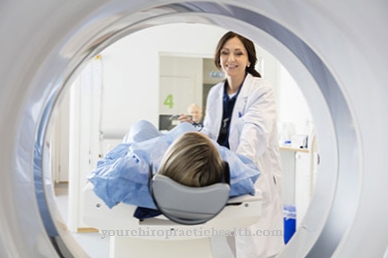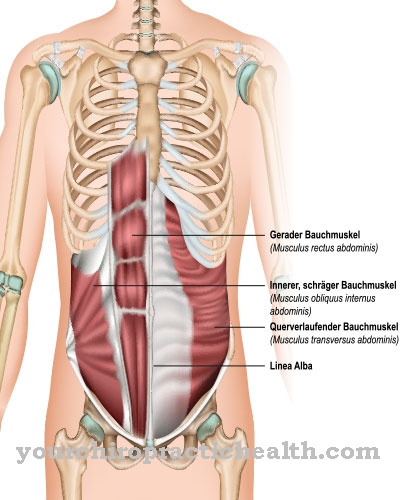The Hidradenitis suppurativa (Acne inversa) is an inflammatory skin disease with a progressive-chronic course, which affects women somewhat more often than men. The age peak for hidradenitis suppurativa is between the ages of 20 and 30.
What is hidradenitis suppurativa?

© xtaska - stock.adobe.com
As Hidradenitis suppurativa is a chronic inflammatory disease of the sebum glands and the terminal hair follicles connected to them, which is accompanied by painful lump and abscess formation.
The skin changes usually develop below the armpits, the female breast, in the groin area and in the perianal and perigenital area. Initially, the disease manifests itself in the form of giant comedones (large blackheads) and solitary palpable nodules, which later change into larger collections of pus with deeper fistulas and pronounced nodules that converge into strands.
The disease can cause serious somatic and psychological disorders as a result of its pain symptoms and the foul-smelling secretion. Hidradenitis suppurativa is also associated with an increased risk of skin, oral mucosa and liver cancer.
root cause
The exact etiology of the Hidradenitis suppurativa has not yet been clearly clarified. It is known that due to a form of ichthyosis (cornification disorder), horn material is increasingly accumulated in the sebum glands and hair roots.
In addition, there is a bacterial infection (usually with Staphylococcus aureus) and purulent inflammation of the sebum gland in the affected areas. Due to the accumulation of pus, the sebum gland cyst ruptures, so that the inflammation spreads to the adjacent tissue and a secondary sweat gland inflammation can be caused. Painful abscesses develop and then fistulas develop.
Bacterial colonization of the blood vessels in the subcutaneous tissue can also cause life-threatening sepsis (blood poisoning). Nicotine consumption (around 80 percent of those affected are smokers), obesity, a weakened immune system due to diabetes mellitus, increased sebum production due to male sex hormones and stress are considered to be triggering or promoting factors.
Due to the familial accumulation, a genetic predisposition for hidradenitis suppurativa is also being discussed.
Symptoms, ailments & signs
Hidradenitis suppurativa manifests itself primarily as inflamed sebum glands, which are usually filled with pus or wound fluid. More ulcers, abscesses, or fistulas usually form in the affected area. These increase in size as the disease progresses and often also fill with pus.
There is severe pain when touched. The changes in the skin significantly limit the mobility of the affected body region. Usually, even with slight friction, intense pain or even the abscesses tear open. The pain often occurs at night and at rest and leads to sleep problems for those affected. Furthermore, there are wound healing disorders.
This causes further infections and inflammations in the affected skin areas, and the general condition of the person concerned deteriorates increasingly. Many patients develop mental complaints as a result of the skin changes, such as depressive moods or inferiority complexes. The person concerned usually looks exhausted and tired.
Active participation in life no longer takes place. In most cases, the disease leads to withdrawal from social life. The symptoms persist for several days to weeks and quickly subside with appropriate treatment.
Diagnosis & course
A Hidradenitis suppurativa is diagnosed based on clinical symptoms. The diagnosis is confirmed by a biopsy followed by a histological examination, which also serves to differentiate the diagnosis from similar clinical pictures such as Crohn's disease with skin involvement or tuberculosis cutis colliquativa.
In addition, other infection-related diseases with an analogous clinical picture (including trichophytia, sporotrichosis, lymph granuloma inguinale) should be excluded. If there is pronounced fistula formation, this can be made visible by means of a contrast display or a contrast agent in the X-ray image (fistulography).
If left untreated, hidradenitis suppurativa has a progressive-chronic course, which leads to complete destruction of the affected skin and subcutaneous fat. Since the disease only rarely shows spontaneous remissions, hidradenitis suppurativa should always be treated consistently and adequately in order to avoid complications and social consequences of the usually recurrent disease.
Complications
Hidradenitis suppurativa leads to the formation of ulcers and fistulas. These are often filled with pus and can cause you severe pain. This pain also leads to restricted mobility. It is not uncommon for patients to suffer from depression and other psychological disorders due to restricted mobility.
The entire everyday life of the patient is severely restricted by hidradenitis suppurativa and the quality of life is reduced. The person concerned looks exhausted and tired and no longer takes an active part in life. In most cases, the disease also leads to social complaints and not infrequently to exclusion. Nocturnal pain leads to sleep problems and thus irritation of the patient.
Furthermore, the patient suffers from wound healing disorders, so that infections and inflammations can develop more easily and quickly. The immune system is also weakened. The treatment mainly uses antibiotics and surgical interventions, although there are usually no particular complications. The complaints can be limited relatively well. Life expectancy is usually not reduced by the disease.
When should you go to the doctor?
People who do not have the flu or cold but still have swollen lymph nodes should consult a doctor. The swellings should be clarified and examined more closely. It is particularly worrying when the lymph shows changes over several weeks. A doctor's visit is necessary as soon as the swelling spreads or the lump formation increases in size. If further ulcers, abscesses or diffuse bumps develop on the body, a doctor should be contacted.
Persistent or spreading skin abnormalities and discoloration must also be examined medically. If the headache persists, the body temperature rises or the body feels abnormally warm, it is advisable to consult a doctor. If psychological abnormalities occur, the behavior of the person concerned changes to a considerable extent or mood swings set in, a doctor should be asked for advice and support. A reduced level of well-being, a loss of quality of life or a decrease in the usual level of performance should be discussed with a doctor.
If the usual everyday duties can no longer be fulfilled, a visit to the doctor is advisable. If the person concerned suffers from sleep disorders, decreased concentration or attention, he needs remedy. If you feel sick, feel unwell or feel generally weak, you should consult a doctor to find the cause of the abnormalities.
Doctors & therapists in your area
Treatment & Therapy
A Hidradenitis suppurativa is treated conservatively and / or surgically as standard. As part of conservative therapy, for example, hormonal imbalances can be compensated for with drugs using antiandrogens (women) or 5-alpha reductase inhibitors (men).
Antibiotics can stabilize and reduce the symptoms resulting from bacterial inflammation. In addition, the use of TNF-alpha antagonists, which have proven themselves in Crohn's disease and inhibit the tumor necrosis factor (TNF) involved in inflammatory processes in the organism, is being tested in clinical studies for the treatment of hidradenitis suppurativa. The first results are promising in this regard.
However, since the conservative therapeutic measures have so far not proven to be sufficiently effective, surgical intervention is indicated in the long term due to the high risk of spreading the inflammatory reactions and extensive fistula formation. As part of a surgical procedure, all affected skin areas are completely excised.
Depending on the extent of the defect and the individual influencing factors (including any wound healing disorders that may be present), different surgical procedures are available. While with a close-up flap after the excision wound closure is achieved by moving skin tissue from adjacent structures, and with split-thickness skin grafting the wound is closed with the patient's own skin grafts (e.g. from the thigh or the back of the head), open wound healing is aimed for with secondary healing.
In addition, those affected by hidradenitis suppurativa are recommended to follow a diet similar to that for multiple sclerosis and rheumatic diseases, as well as avoiding tight clothing and obesity.
Outlook & forecast
Hidradenitis suppurativa is a very protracted disease that severely affects the quality of life of the affected patient. To date, there are still no convincing concepts for a therapy with complete healing.
Without treatment, the prognosis is not good. Based on the existing inflammation, larger abscesses can develop in these cases. Finally, phlegmon also develop on the subcutaneous tissue. The extensive abscesses often lead to an intensive formation of fistulas. It is not uncommon for the phlegmon in the subcutaneous tissue to develop into a potentially fatal sepsis.
Even with treatment, the disease is usually long-lasting and recurring. This in turn causes severe psychological stress for those affected. In addition to the chronic and excruciating pain, the inflammatory skin changes are perceived as strongly stigmatizing. The affected patients often have to be on sick leave for a long time during the very protracted therapy, which in turn can lead to job loss and social exclusion. This is why this disease has also been recognized as a disability under social law in Germany. In addition to chronic pain, patients often suffer from mental illness due to social exclusion.
So far, there is hardly any experience of treatment success, as there is still no uniform therapy concept. However, some smaller clinics have already reported successes in using various laser methods.
prevention
Since the etiology has not yet been conclusively clarified, one can Hidradenitis suppurativa cannot be prevented. Avoiding possible triggering factors such as nicotine consumption or obesity can at least favor the course of hidradenitis suppurativa if there is a familial prevalence (accumulation).
Aftercare
In most cases of the disease hidradenitis suppurativa, the patient has very few or no options or direct follow-up measures available. The patient is primarily dependent on a quick and early detection of the disease so that there are no further complications or complaints. The earlier the hidradenitis suppurativa is recognized and treated, the better the further course of this disease is usually.
A doctor should therefore be consulted at the first signs or symptoms of the disease. In most cases, the disease is treated by taking medication, mainly antibiotics. The affected person should ensure that they are taken regularly with the correct dosage. If anything is unclear or if you have any questions, you should always consult a doctor first.
Those affected should also consult a doctor in the event of interactions or side effects. Since hidradenitis suppurativa can also impair wound healing, injuries should generally be avoided. Wounds need to be particularly cared for so that there are no infections or inflammations. Most of the time, the disease does not reduce life expectancy.
You can do that yourself
Patients with hidradenitis suppurativa are noticeably restricted in their everyday life due to the unpleasant symptoms. The inflamed foci and fistulas cause pain both in a resting position and when moving. Therefore, those affected suffer from reduced mobility and, as a result, from irritability. To relieve the pain, make sure that the clothing does not press or rub against the inflammation, especially when moving. Patients choose cosmetics together with a pharmacist or the treating doctor so as not to expose the inflamed areas to additional irritation.
Sensitive hygiene of the diseased skin areas is also important. The inflammation should be kept clean and free of contamination, but the fistulas should be protected from further irritation during cleaning. Some of the patients are no longer able to perform certain types of sport without difficulty and therefore look for physical activity that is compatible with the disease.
In order to promote the success of the treatment, the patients also work on reducing known risk factors for the disease. For example, those affected quit smoking and become overweight. They also avoid additional psychological strain and stress.




.jpg)








.jpg)

.jpg)
.jpg)











.jpg)